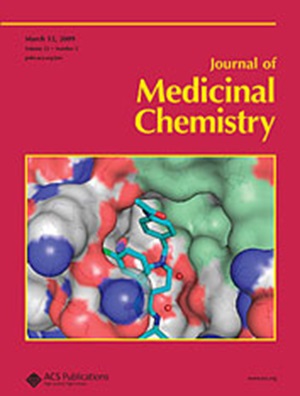Discovery and Pharmacological Evaluation of Potent and Highly Selective PARP1 Inhibitors
IF 6.8
1区 医学
Q1 CHEMISTRY, MEDICINAL
引用次数: 0
Abstract
The first-generation approved PARP inhibitors (PARPi) inhibit both PARP1 and PARP2, which may result in significant hematological toxicity. To overcome this potential issue, we designed and synthesized a series of small molecules that are highly selective PARP1 inhibitors. Among these, (S)-G9 exhibited an IC50 of 0.19 nM against PARP1, with a remarkable 137-fold selectivity over PARP2 and high antiproliferative activity in BRCA mutant MDA-MB-436 cells with an IC50 of 1.5 nM. Furthermore, (S)-G9 is a PARP1 selective trapper, with a thousand-fold less activity toward PARP2. (S)-G9 inhibited tumor growth in the BRCA mutant MDA-MB-436 xenograft model and showed synergistic efficacy in combination with irinotecan in the HCT116 xenograft model, suggesting that it could be a promising candidate drug combined with chemotherapy for the treatment of cancer. These findings indicate that the strategy proposed in this study is highly significant for the development of selective PARP1 inhibitors.

强效和高选择性PARP1抑制剂的发现和药理学评价
第一代批准的PARP抑制剂(PARPi)可抑制PARP1和PARP2,这可能导致显著的血液学毒性。为了克服这一潜在问题,我们设计并合成了一系列具有高选择性PARP1抑制剂的小分子。其中,(S)-G9对PARP1的IC50为0.19 nM,对PARP2的选择性为137倍,对BRCA突变体MDA-MB-436细胞具有较高的抗增殖活性,IC50为1.5 nM。此外,(S)-G9是PARP1选择性诱捕器,对PARP2的活性低千分之一。(S)-G9在BRCA突变体MDA-MB-436异种移植物模型中抑制肿瘤生长,并在HCT116异种移植物模型中与伊立替康联合显示协同效应,提示其可能是一种有前景的联合化疗治疗癌症的候选药物。这些发现表明,本研究提出的策略对于开发选择性PARP1抑制剂具有重要意义。
本文章由计算机程序翻译,如有差异,请以英文原文为准。
求助全文
约1分钟内获得全文
求助全文
来源期刊

Journal of Medicinal Chemistry
医学-医药化学
CiteScore
4.00
自引率
11.00%
发文量
804
审稿时长
1.9 months
期刊介绍:
The Journal of Medicinal Chemistry is a prestigious biweekly peer-reviewed publication that focuses on the multifaceted field of medicinal chemistry. Since its inception in 1959 as the Journal of Medicinal and Pharmaceutical Chemistry, it has evolved to become a cornerstone in the dissemination of research findings related to the design, synthesis, and development of therapeutic agents.
The Journal of Medicinal Chemistry is recognized for its significant impact in the scientific community, as evidenced by its 2022 impact factor of 7.3. This metric reflects the journal's influence and the importance of its content in shaping the future of drug discovery and development. The journal serves as a vital resource for chemists, pharmacologists, and other researchers interested in the molecular mechanisms of drug action and the optimization of therapeutic compounds.
 求助内容:
求助内容: 应助结果提醒方式:
应助结果提醒方式:


